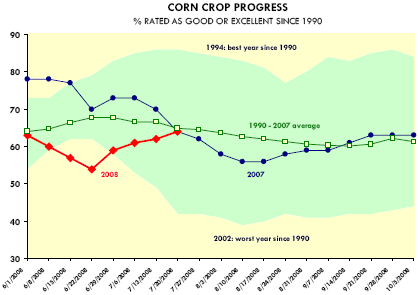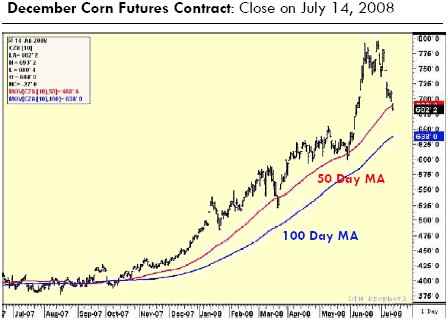



CME: Corn and Feedstock Futures
US - CME's Daily Livestock Report for 14 July 2008.Corn and feedstock futures declined sharply in Monday’s trading session, which must have been welcome news for livestock producers and meat protein buyers across the country.
| E-Livestock Volume | 14-Jul | 11-Jul | 7-Jul |
|---|---|---|---|
| LE (E-Live Cattle): | 20,873 | 16,755 | 13,630 |
| GF (E-Feeder Cattle): | 895 | 1,331 | 1,066 |
| HE (E-Lean Hogs): | 19,053 | 16,397 | 12,478 |
The December corn futures contract closed at $682.25, almost a full $1 per bushel lower than where the market was trading on July 2. The Monday close broke below the 50-day moving average, an important technical signal from a trend following perspective. Soybean meal futures also were lower some $13 on the day (Dec contract) but that soybeans and soybean by-product contracts have not seen the declines observed in the corn market.
After a really scary start of the corn growing season, weather patterns in the last couple of weeks have been much better for the new corn crop, leading to a notable improvement in crop conditions. The latest USDA crop conditions report showed further improvement in corn crop conditions, with 64% of the corn crop currently rated in good or excellent condition. Crop conditions normally improve into early July as warmer weather and relatively good moisture conditions help the crop develop quickly.
The current rating of crops in good or excellent condition is at levels similar to a year ago and the long term average (since 1990). Crop conditions show that the situation has improved significantly compared to early June reports but they do remain behind last year’s pace in some key areas. The latest data for week ending July 13 show that 58% of the IA crop was rated in good/excellent condition compared to 63% a year ago. The situation appears to be worse in Illinois, where 65% of the corn crop was rated as good/excellent, compared to 79% a year ago. On the other hand, 63% of the crop in Indiana was reported in good/excellent condition, a 20 point improvement over a year ago.
Reports for later in the week and into the weekend point to weather patterns that will continue to be helpful to the new corn crop. This remains a weather market for the moment and the market will likely wait until the new crop is in before re-focusing its attention on the demand side of the coin. The next two to three weeks will be critical for the new crop as corn enters the delicate pollination phase. Dry and hot conditions take a toll during this period and negatively impact overall yields. On the other hand, better than average moisture and heat conditions will improve yield prospects this fall. The latest USDA report did not make any significant changes to the expected yield per acre, leaving it at around 148 bu./acre. If conditions continue to improve, however, we could see yield estimates increase in the August report.













